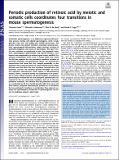| dc.contributor.author | Endo, Tsutomu | |
| dc.contributor.author | Freinkman, Elizaveta | |
| dc.contributor.author | de Rooij, Dirk G. | |
| dc.contributor.author | Page, David C | |
| dc.date.accessioned | 2018-07-05T13:57:06Z | |
| dc.date.available | 2018-07-05T13:57:06Z | |
| dc.date.issued | 2017-11 | |
| dc.date.submitted | 2017-06 | |
| dc.identifier.issn | 0027-8424 | |
| dc.identifier.issn | 1091-6490 | |
| dc.identifier.uri | http://hdl.handle.net/1721.1/116786 | |
| dc.description.abstract | Mammalian spermatogenesis is an elaborately organized differentiation process, starting with diploid spermatogonia, which include germ-line stem cells, and ending with haploid spermatozoa. The process involves four pivotal transitions occurring in physical proximity: spermatogonial differentiation, meiotic initiation, initiation of spermatid elongation, and release of spermatozoa. We report how the four transitions are coordinated in mice. Two premeiotic transitions, spermatogonial differentiation and meiotic initiation, were known to be coregulated by an extrinsic signal, retinoic acid (RA). Our chemical manipulations of RA levels in mouse testes now reveal that RA also regulates the two postmeiotic transitions: initiation of spermatid elongation and spermatozoa release. We measured RA concentrations and found that they changed periodically, as also reflected in the expression patterns of an RA-responsive gene, STRA8; RA levels were low before the four transitions, increased when the transitions occurred, and remained elevated thereafter. We found that pachytene spermatocytes, which express an RA-synthesizing enzyme, Aldh1a2, contribute directly and significantly to RA production in testes. Indeed, chemical and genetic depletion of pachytene spermatocytes revealed that RA from pachytene spermatocytes was required for the two postmeiotic transitions, but not for the two premeiotic transitions. We conclude that the premeiotic transitions are coordinated by RA from Sertoli (somatic) cells. Once germ cells enter meiosis, pachytene spermatocytes produce RA to coordinate the two postmeiotic transitions. In combination, these elements underpin the spatiotemporal coordination of spermatogenesis and ensure its prodigious output in adult males. | en_US |
| dc.publisher | National Academy of Sciences (U.S.) | en_US |
| dc.relation.isversionof | http://dx.doi.org/10.1073/PNAS.1710837114 | en_US |
| dc.rights | Article is made available in accordance with the publisher's policy and may be subject to US copyright law. Please refer to the publisher's site for terms of use. | en_US |
| dc.source | PNAS | en_US |
| dc.title | Periodic production of retinoic acid by meiotic and somatic cells coordinates four transitions in mouse spermatogenesis | en_US |
| dc.type | Article | en_US |
| dc.identifier.citation | Endo, Tsutomu et al. “Periodic Production of Retinoic Acid by Meiotic and Somatic Cells Coordinates Four Transitions in Mouse Spermatogenesis.” Proceedings of the National Academy of Sciences 114, 47 (November 2017): E10132–E10141 © 2017 National Academy of Sciences | en_US |
| dc.contributor.department | Massachusetts Institute of Technology. Department of Biology | en_US |
| dc.contributor.mitauthor | Page, David C | |
| dc.relation.journal | Proceedings of the National Academy of Sciences | en_US |
| dc.eprint.version | Final published version | en_US |
| dc.type.uri | http://purl.org/eprint/type/JournalArticle | en_US |
| eprint.status | http://purl.org/eprint/status/PeerReviewed | en_US |
| dc.date.updated | 2018-07-02T14:11:05Z | |
| dspace.orderedauthors | Endo, Tsutomu; Freinkman, Elizaveta; de Rooij, Dirk G.; Page, David C. | en_US |
| dspace.embargo.terms | N | en_US |
| dc.identifier.orcid | https://orcid.org/0000-0001-9920-3411 | |
| mit.license | PUBLISHER_POLICY | en_US |
